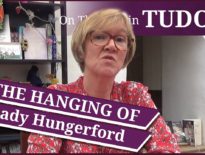On this day in Tudor history, 19th February 1592, the Rose Theatre, an Elizabethan play house built by Philip Henslowe, was opened on Bankside in London.
Plays performed at the theatre included Shakespeare’s “Henry VI Part 1” and “Titus Andronicus”, Kyd’s “Spanish Tragedy”, and Marlowe’s “Doctor Faustus”, “The Jew of Malta” and “Tamburlaine the Great”. But, unfortunately, the Rose Theatre was abandoned by 1605.
Find out more about the Rose Theatre in today's talk.
Here's the documentary that I mentioned:
The Rose Theatre website is at http://www.rosetheatre.org.uk/
Also on this day in Tudor history, 19th February 1547, King Edward VI had his coronation procession through the streets of London. Find out more in last year’s video:
Also on this day in history:
- 1473 – Birth of Nicholas Copernicus, the Renaissance mathematician and astronomer, in Thorn, in the province of Royal Prussia, Poland. Copernicus is known for his theory of heliocentric cosmology, or the idea that the sun was stationary in the centre of the universe and that the earth revolved around it.
- 1546 – William Cavendish was appointed Treasurer of the Privy Chamber. He later claimed that he had paid £1000 for the position.
- 1567 – The imprisoned Margaret Douglas, Countess of Lennox, was informed of the murder of her son, Henry Stewart, Lord Darnley, by William Cecil’s wife, Mildred, and Lady William Howard. The Spanish ambassador recorded that Margaret's grief was such “that it was necessary for the Queen to send her doctors to her”.
- 1598 – Death of Jasper Heywood, Jesuit and poet, in Naples. Heywood had been deported to France in January 1585, after being imprisoned in the Tower of London for treason, and was then summoned to Rome. He never returned to England.
- 1601 – Death of Thomas Fanshawe, at Warwick Lane. He was buried in the south aisle of Ware church in Hertfordshire. Fanshawe was an Exchequer official during Elizabeth I's reign.
Transcript:
On this day in Tudor history, 19th February 1592, the Rose Theatre, an Elizabethan play house, was opened on Bankside in London.
In 1585, London businessman and property developer, Philip Henslowe, leased a tenement and gardens known as the Little Rose. In 1587, with the help of grocer John Cholmley and carpenter John Griggs, Henslowe built The Rose Theatre, which opened in 1592. The Rose Theatre website tells of how not much is known about the theatre between 1587 and 1592, but we have records from 1592 when Henslowe started to keep an account book, “Henslowe’s Diary”. In that same year, Henslowe’s step-daughter married Edward Alleyn, a well-known actor, who moved his group of actors. made up from the Admiral’s Men and Lord Strange’s Men acting groups, to the Rose Theatre. The theatre was then enlarged for this troupe of actors, and the extra spectators who would come to see them.
“Henslowe’s Diary” and Edward Alleyn’s papers from the College of God’s Gift (Dulwich College), which he founded in 1619, record not only the expenditure involved in extending the Rose Theatre and its upkeep, but also the plays that were staged there, the number of spectators and also the props and costumes used. From these records, we know that the Rose Theatre’s repertory included Shakespeare’s “Henry VI Part 1” and “Titus Andronicus”, Kyd’s “Spanish Tragedy”, and Marlowe’s “Doctor Faustus”, “The Jew of Malta” and “Tamburlaine the Great”.
In 1594-1596 the Swan Theatre was built, followed by the Globe Theatre in 1599. These rival theatres adversely affected the popularity of the Rose. When in June 1600, the Privy Council decreed that only two theatres would be allowed to stage plays – the Globe Theatre and the Fortune Theatre (also built by Henslowe and Alleyn) – the Rose Theatre began its decline and was abandoned by 1605, if not earlier.
In 1988, the demolition of a 1950s office block meant that the site of the Rose Theatre could be investigated, and in 1989 a campaign to “Save the Rose” was launched by Lord Olivier (actor Laurence Olivier). In May 1989, archaeologists from the Museum of London were successful in uncovering two thirds of the Rose Theatre’s ground plan. As well as giving vital information on how the Rose Theatre was built and how it would have looked, the site gave up over 700 precious Elizabethan artefacts: coins, fragments of the money boxes used to collect entrance money, tokens, hazelnut shells from the nuts eaten by the Elizabethan audiences, and jewellery. The articles found are now kept at the Museum of London.




Leave a Reply